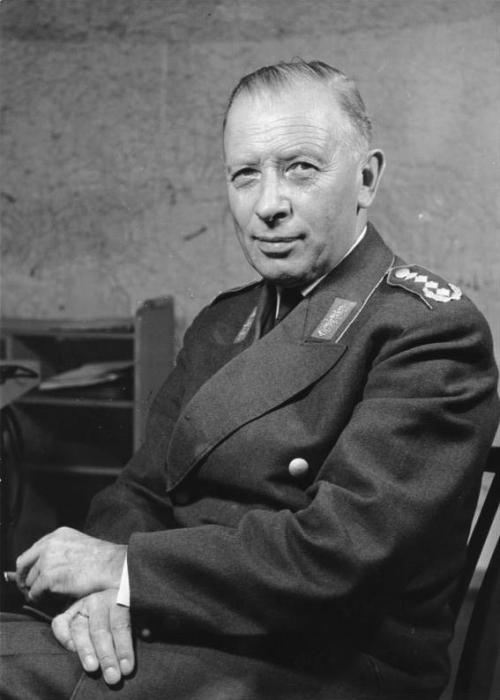
Heusinger, Adolf, Generalinspekteur der BW 1.4.1957 - 31.3.1961
Views: 19321
General Adolf Heusinger (August 4, 1897 – November 30, 1982) was a German general officer who briefly served as Adolf Hitler’s Chief of the General Staff of the Army during World War II and served as the first Inspector General of the Bundeswehr, the West German armed forces, from 1957 to 1961. Heusinger served as Chairman of the NATO Military Committee from 1961 to 1964.
Heusinger was born in Holzminden, in the Duchy of Brunswick, German Empire. He entered the Imperial German Army on June 17, 1915, and was assigned to 7. Thüringisches Infanterie-Regiment Nr. 96, an infantry regiment raised in the Thuringia region of Germany.
During World War I, he was decorated with the Iron Cross 2nd Class and Iron Cross 1st Class, Brunswick’s War Merit Cross 2nd Class, the Reuss Silver Merit Medal with Swords, the Reuss Honor Cross 3rd Class with Swords and the Wound Badge in Black.
Heusinger served in Berlin with the Troop Office (Troop Office was the German Army’s covert General Staff during the Weimar Republic era, as the Treaty of Versailles also forbade that institution) from October 1931 until August 1934, and then returned to troop assignments.
He was made chief operations officer of the 11th Division in October 1935, where he served until August 1937. In the meantime, he was promoted to major on March 16, 1936.
With the rise of the Nazis in Germany and Adolf Hitler’s assumption of power, the restrictions of the Treaty of Versailles were abrogated and the German General Staff was officially reestablished. In August 1937, Heusinger was assigned to the Operations Staff (Operationsabteilung) of the Army General Staff as a general staff officer. He served there, being promoted to lieutenant colonel on March 20, 1939, and remained in that position until October 15, 1940, when he became its chief.
With the outbreak of the Second World War, the German Army High Command (OKH) assumed its wartime organization. Heusinger accompanied the field staff and assisted in the planning of operations in Poland, Denmark, Norway, and France, and the Low Countries (a coastal region in western Europe, consisting especially of the Netherlands and Belgium).
He was promoted to colonel on August 1, 1940, and became chief of the Operationsabteilung in October 1940, making him number three in the Army planning hierarchy, after the Chief of the General Staff, General Franz Halder, and the Deputy Chief of the General Staff/Chief Quartermaster (Oberquartiermeister I), General Friedrich Paulus. After the invasion of the Soviet Union in June 1941, the OKH became primarily responsible for planning operations in that theater.
Heusinger remained chief of the Operationsabteilung and was promoted to Generalmajor (major general) on January 1, 1942, and to Generalleutnant (lieutenant general) on January 1, 1943. In June 1944, General Zeitzler became ill, and on June 10, Heusinger temporarily assumed his office as Chief of the General Staff of the Army. In this capacity, he attended the meeting at Adolf Hitler’s “Wolf’s Lair” on July 20, 1944, and was standing next to Hitler when the bomb planted by Colonel Claus von Stauffenberg exploded.
Heusinger was hospitalized for his injuries in the explosion but was arrested and interrogated by the Gestapo to determine his role, if any, in the July Plot. Although there was evidence that Heusinger had had contacts with many of the conspirators, there was insufficient evidence to directly connect him to the plot, and he was freed in October 1944. However, he was placed into the “Führer-Reserve” and was not assigned to another position until March 25, 1945, when he was made chief of the armed forces mapping department. He was taken prisoner by the Western Allies in May 1945.
A prisoner of war from 1945 to 1947, Heusinger testified during the Nuremberg Trials.
According to documents released by the German intelligence agency (Bundesnachrichtendienst, or BND) in 2014, Heusinger may have been part of the Schnez-Truppe, a secret army that veterans of the Wehrmacht and Waffen-SS sought to establish in the early ’50s. He was, according to news reports, wanted by the Russians in respect of organizing the Koriukivka massacre (mass murder of 6,700 residents of Koriukivka in Ukraine on 1-2 March 1943 by German SS. On 9 March, the Germans returned to Koriukivka and burned alive some elderly people who had returned to the village after escaping thinking it was safe).
In 1950, Heusinger became an advisor on military matters to Konrad Adenauer, the first Chancellor of West Germany. With the establishment of the West Germany Army Bundeswehr in 1955, Heusinger returned to military service. He was appointed a Generalleutnant (lieutenant general) on November 12, 1955. in the Bundeswehr and Chairman of the Military Leadership Council.
In March 1957, he succeeded Hans Speidel as chief of the Bundeswehr’s all-armed forces department.
Shortly thereafter, in June 1957, Heusinger was promoted to full general and named the first Inspector General of the Bundeswehr, and served in that capacity until March 1961. In April 1961, he was appointed Chairman of the NATO Military Committee in Washington, D.C., where he served until 1964 when he retired.
Heusinger died in Cologne on November 30, 1982, aged 85.
Source: InSerbia
Origins of images: Facebook, Twitter, Wikimedia, Wikipedia, Flickr, Google, Imageinjection & Pinterest.
Read our Disclaimer/Legal Statement!
Donate to Support Us
We would like to ask you to consider a small donation to help our team keep working. We accept no advertising and rely only on you, our readers, to keep us digging the truth on history, global politics and international relations.
[wpedon id=”4696″ align=”left”]
FOLLOW US ON OUR SOCIAL PLATFORMS










